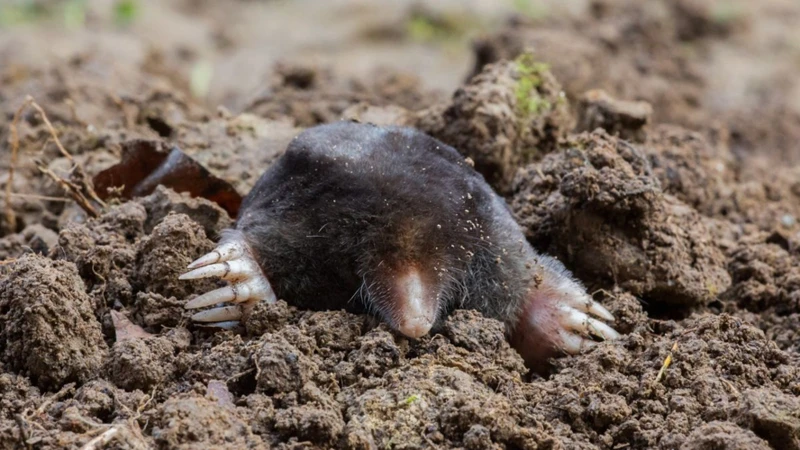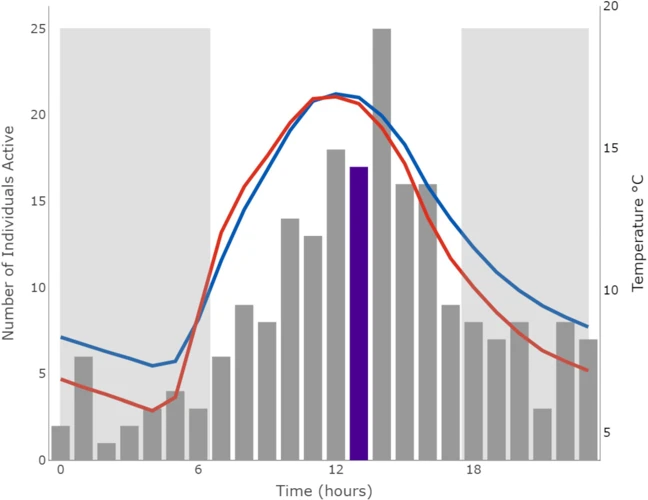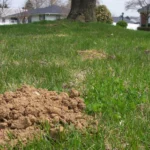The world beneath our feet is fascinating and mysterious, and one of its most enigmatic inhabitants is the mole. These elusive creatures spend most of their lives underground, busily burrowing through the soil in search of food and shelter. Despite being notorious for wreaking havoc on lawns, gardens and farmland, moles remain a subject of fascination for many. How do they navigate their underground world? What motivates their behavior? And how do they adapt to changes in their environment throughout the seasons? In this article, we’ll take a deep dive into the life of moles, exploring their habitats, behavior, and how they cope with the challenges of seasonal changes.
Mole Habitats

As we delve into the hidden world of moles, one of the most important factors to consider is their habitat. Moles can be found in a variety of environmental conditions, ranging from residential yards to woodlands. Understanding the different habitats where moles reside can help us better understand their behavior and implement effective control methods. In this section, we will explore the various mole habitats in detail, including the types of environments that they thrive in and the best techniques for detecting their presence. To learn more about mole habitats in your own backyard, check out our article on mole habitats in yard.
1. Residential Areas
Residential areas, such as parks and gardens, are popular habitats for moles. They prefer areas with moist and loose soil, as it allows for easier digging of tunnels. In residential areas, moles feed on earthworms, which are also attracted to the moist soil.
Moles are attracted to residential areas because of:
- The loose and moist soil that is easy to dig tunnels in
- The abundance of earthworms, which make up a large part of their diet
- Vegetation that provides cover and shelter
However, moles can also cause damage to residential areas, as their tunnels can ruin lawns and gardens. To detect mole tunnels in residential areas, look for raised ridges and mounds of soil. These are signs that moles are present, and you may need to employ control methods to remove them.
It’s important to note that removing moles from residential areas should be done humanely, and without the use of chemicals that can harm other wildlife or domestic animals. Prevention is also key to keeping moles out of residential areas. Creating an unattractive environment for moles, such as using plants they find unappealing, can help discourage them from taking up residence in your lawn or garden.
Consider utilizing natural control methods, such as introducing predators like owls or encouraging snakes to inhabit the area. Trapping is another option for removing moles from residential areas, but it should only be done by professionals who are trained in humane methods.
Moles are commonly found in residential areas because of the loose, moist soil that is easy to dig tunnels in, the abundance of earthworms, and the vegetation that provides shelter. To remove moles from residential areas, humane methods such as natural control or trapping should be considered. Prevention is key, and creating an unattractive environment for moles by using plants they don’t like can help deter them from settling in your yard. For more information on mole habitats and removal methods, see moisture in mole habitats, vegetation in mole habitats, and mole habitat removal articles.
2. Farmland
Farmland is another common habitat of moles. Moles can cause significant damage to crops, gardens, and farm equipment. Their tunnels can be especially hazardous to livestock, causing potential injuries or worse. Moles are attracted to farmland because of the abundance of insects and earthworms in the soil, which make up a significant portion of their diet.
Moles in farmland during different seasons:
- In the spring, moles are particularly active in farmland as the soil warms up, and insects and earthworms become more plentiful. During this time, they may have multiple litters of pups.
- In the summer, the soil may become dry, and the mole’s food source may become less abundant due to drought. As such, moles may move to areas with more favorable soil conditions.
- In the fall, moles will be busy preparing for the winter months by storing food and building tunnels closer to the surface. This is a good opportunity for farmers to identify and eliminate mole activity before the winter.
- In the winter, moles may burrow deeper into the soil to escape the cold and lack of food.
Prevention methods:
Prevention is key in farmland as moles can cause significant damage. Farmers can create an unattractive environment for moles by regularly mowing their fields, plowing them, and removing any debris that may shelter insects (which will then attract moles). Farmers should also monitor their fields for the signs of mole activity, such as raised tunnels and mounds of dirt, and take appropriate control measures.
Control methods:
- Natural control methods include the introduction of predators that will feed on moles, such as snakes and birds of prey.
- Chemical control methods may include fumigation or the use of poison baits, although these can be harmful to other wildlife and domesticated animals.
- Trapping is a humane and effective control method. Live traps can be set in the mole’s tunnel and then relocated to another location, while lethal traps can be used to kill the mole quickly and humanely.
- Professional mole control services are available for large-scale mole infestations, such as those found on farmland.
Farmers should take appropriate measures to control mole activity on their land to prevent damage to crops, equipment, and livestock. They can create an unattractive environment for moles and use natural or professional control methods to eliminate mole activity. For more information on different soil types that moles prefer, check out our article on soil type and mole habitats. It’s also important to know how to detect mole tunnels to take control measures before it’s too late.
3. Woodland
Woodland habitats are also known to be favorable locations for moles, particularly in areas with thick leaf litter and vegetation. According to research, woodland areas provide an abundance of moist soil and earthworms, which are a staple part of a mole’s diet. These areas also offer moles ample protection from predators such as birds and foxes, thanks to the vegetation cover.
Below is a table summarizing the characteristics of mole habitats in woodland areas, along with the specific challenges in controlling moles in this environment.
| Habitat Characteristics | Control Challenges |
|---|---|
| Damp soil due to high vegetation cover, creating a suitable environment for mole burrowing | Difficulties in finding effective natural and chemical controls as moles are able to avoid unpleasant odors and taste in moist soil |
| Presence of earthworms due to the moist soil, providing an ideal food source for moles | Moles’ preferred food source is abundant in this environment, making it challenging to use bait or poison control methods |
| Vegetation cover offers protection from above-ground predators | Trapping can be difficult due to the dense vegetation cover, making it challenging to locate and access mole burrows |
It can be challenging to control moles in woodland areas due to the favorable habitat conditions and the difficulties in finding effective control methods. Natural control methods may not work as effectively in damp soil and with the presence of abundant food sources, while trapping can be hindered by the dense vegetation. Some landscaping solutions may help to make the environment unattractive to moles, such as planting less attractive vegetation or creating drier soil conditions.
4. Grassland
Grassland habitats are some of the most preferred habitats for moles. This habitat provides a lot of benefits to moles such as an abundant source of food and an ideal place for nesting. Grassland habitats are usually found in open areas such as golf courses, meadows, and parks. Moles prefer to burrow in areas with deep soil that is rich in organic matter.
Mole Behavior in Grassland Habitats
In grassland habitats, moles mostly feed on insects and earthworms that live under the soil. They also like to feed on some species of grasses and forbs. During the breeding season, moles mate and give birth to young ones in the grassland habitat.
Adaptations to Grassland Habitats
To adapt to the grassland habitat, moles have evolved specialized digging mechanisms such as powerful forelimbs, large paws, and sharp claws that enable them to burrow easily through the soil. They also have keen senses of smell, touch, and hearing that help them locate prey and avoid predators.
Seasonal Changes in Grassland Habitats
In the spring, moles in grassland habitats become very active as they search for food and mate. During the summer, the soil in grassland habitats becomes drier, and moles have to dig deeper into the soil to find food and stay hydrated. In the fall, moles in grassland habitats start to prepare for winter by stockpiling food and building nests. During the winter, they become less active and spend more time in their underground burrows.
To keep lawns and other grassy areas unattractive to moles, it’s important to maintain an unfavourable environment by keeping the soil dry and free of excess organic matter. This will make the habitat less attractive to moles and encourage them to seek nesting and feeding grounds elsewhere.
| Grassland Habitats | Benefits to Moles |
|---|---|
| Open areas, such as golf courses, meadows and parks | Abundant source of food, ideal place for nesting |
| Deep soil rich in organic matter | Provides efficient burrowing grounds to moles |
Mole Behavior

As we delve deeper into the world of moles, it is important to understand their behavior. Moles are fascinating creatures with unique habits that ensure their survival. From their feeding behavior to their breeding habits, moles display a wide range of fascinating behaviors. Understanding the behavior of moles is crucial in controlling mole infestations in a humane and effective manner. In the next section, we’ll take a closer look at the different behaviors of moles and what they mean for their underground lifestyle. To keep moles away from your yard, it is crucial to create an environment that is unattractive to moles. You can check out our article on creating an unattractive environment for moles for more information.
1. Feeding Behavior
Moles have a diverse and fascinating feeding behavior, which can vary depending on their location and the season. These small mammals primarily feed on insects and other invertebrates that they find underground, but their eating habits can also extend to roots and bulbs. Let’s take a closer look at some of the specific feeding behaviors of moles:
| Feeding Behavior | Description |
|---|---|
| Surface Feeding | Moles may occasionally feed on the surface, especially during the cooler months. They may eat earthworms, snails, slugs, and various insects. |
| Subterranean Feeding | This is the primary mode of feeding for moles. They dig tunnels in search of underground insects, such as ants, beetles, and grubs. They have been known to consume up to 70-100% of their body weight in food each day. |
| Root and Bulb Feeding | In addition to insects, moles sometimes feed on roots, bulbs, and tubers. This may occur more frequently during times of food scarcity or when the mole’s favorite insect prey is less abundant. |
Moles have a high metabolism and therefore must feed frequently to maintain their energy levels. Their ability to consume large amounts of food each day is also why they can cause significant damage to lawns and gardens. Understanding their feeding behaviors is crucial in developing effective mole control strategies.
2. Breeding Behavior
Moles have a unique breeding behavior that follows a specific pattern. Breeding mole pairs will mate only once a year, during early winter or late fall. The process starts with the female moles releasing pheromones to attract males for mating. Once a male detects the pheromones, he will dig a tunnel to where the female is and mate with her.
After mating, the males move on while the female remains underground to raise the offspring. A typical mole litter consists of 3 to 5 pups, which are born blind and helpless. The pups stay in their nesting chamber and rely on their mother for warmth and food. The mother will suckle her young for about 4 to 5 weeks before the pups start to venture out of the nest.
Breeding patterns for moles can vary depending on different factors, such as food availability and environmental conditions. In areas with favorable conditions, mole populations can thrive and show explosive growth, resulting in increased breeding activity.
It’s important to note that moles have a high mortality rate, and not all pups survive to adulthood. Factors such as predation, disease, and accidents can significantly impact mole populations.
To summarize: Moles mate once a year during early winter or late fall, and the litter consists of 3-5 pups born blind and helpless. After about a month, the pups start to venture out of the nest. Breeding patterns can vary depending on environmental conditions, and high mortality rates can impact mole populations.
| Breeding Behavior of Moles: |
|---|
| Moles mate only once a year, during early winter or late fall. |
| Female moles release pheromones to attract males for mating. |
| After mating, the male moves on, and the female stays underground to raise the offspring. |
| A typical mole litter consists of 3 to 5 pups, which are born blind and helpless. |
| Pups stay in their nesting chamber and rely on their mother for warmth and food. |
| The mother suckles her young for about 4 to 5 weeks before the pups start to venture out of the nest. |
3. Habitat Selection Behavior
Moles are known for their exceptional habitat selection behavior. They are burrowing animals and are equipped with special adaptations that allow them to create elaborate underground tunnel systems. Moles typically create these systems in areas with loose, moist soil that is easy to dig through.
Factors affecting habitat selection
The habitat selection behavior of moles is influenced by several factors, including soil type, vegetation cover, moisture levels, and the availability of food. Moles prefer soil that is loose and porous, which allows them to burrow easily. They also prefer areas with high moisture levels, as these conditions make it easier for them to tunnel through the soil.
Habitat selection in residential areas
In residential areas, moles often burrow in lawns and gardens. This is because these areas offer loose soil and a consistent supply of insects and worms, which make up the majority of a mole’s diet.
Habitat selection in farmland
Farmland provides moles with an abundance of food sources, including earthworms and grubs. However, their activities can be destructive to crops, and it is not uncommon for farmers to take steps to control their populations.
Habitat selection in woodland
Moles are known to burrow in woodland areas, particularly those with loose, moist soil. They are less likely to burrow in areas with dense vegetation cover, as this makes it more difficult for them to maneuver underground.
Habitat selection in grassland
Grassland areas offer moles with a plentiful supply of insect larvae, which they feed on. These areas often have loose, well-drained soils that make it easier for moles to make their tunnels.
Moles show a strong preference for habitats with loose, moist soil and a consistent supply of food. They are adaptable creatures and are capable of thriving in a variety of different environments. Understanding their habitat selection behavior is crucial in developing effective control methods.
Seasonal Changes in Mole Habitats and Behavior

As seasons change, so do the habitats and behavior of moles. These small subterranean mammals have adapted to different environments such as residential areas, farmlands, woodlands, and grasslands. Throughout the year, their feeding, breeding, and habitat selection behaviors vary greatly. Understanding these seasonal changes is crucial for effective mole control methods that can range from natural remedies to professional services. Let’s delve into the fascinating underground world of moles and explore the changes in their habitats and behavior throughout the year.
1. Spring
During spring, the soil softens and becomes easier for moles to dig through. As the temperatures rise, moles become more active and their feeding behavior changes. They begin to feed on earthworms, grubs, and insects that emerge from the soil. In spring, moles also start breeding and searching for mates.
In residential areas, moles may dig around gardens and lawns searching for food, which can cause damage to the vegetation. In farmland, moles may dig through tilled fields, causing harm to crops. In woodland and grassland habitats, moles may create tunnels and mounds that affect the natural environment.
In terms of habitat selection behavior, during spring, moles may move to shallower depths in the soil to take advantage of the moist conditions found near the surface. This can lead to increased visibility of the tunnels and mounds they create.
Spring is also a good time for mole control methods that use natural predators, such as cats and birds of prey, as they are also becoming more active during this time. However, it is important to note that some natural control methods, such as introducing predators, can have unintended consequences and harm the ecosystem. It is recommended to consult with a professional mole control service before implementing any control measures.
2. Summer
During the summer season, moles continue to be active and are often seen above ground as they search for food. They tend to be more aggressive in their hunting as their preferred food sources, such as earthworms, become more abundant. Here’s a table showing the behavior and habitat changes of moles during the summer season:
| Behavior | Habitat Changes |
|---|---|
| Increased activity: Moles are very active in the summer, spending more time above ground in search of food. | Grass: In summer, moles tend to stay in grassy areas as the soil is easier to dig due to higher moisture content. |
| Aggressive hunting: As earthworms and other food sources become more abundant, moles become more aggressive in their hunting. | Mulch and compost: Mulch and compost provide a good food source for moles during the summer season. |
| Less burrow maintenance: In summer, moles tend to focus more on searching for food than maintaining their burrow systems. | Golf courses: Moles may be more prevalent on golf courses in the summer, as the grassy areas provide a good habitat and food source. |
It’s important to note that while moles can be beneficial to soil health and aeration, their digging habits can be destructive to lawns and gardens. It’s also important to take measures to prevent moles from entering your property, as they can quickly multiply and cause extensive damage. Consider natural control methods such as planting pest-resistant plants or using castor oil repellents, or seek professional mole control services for more severe infestations.
3. Fall
During fall, moles prepare for the upcoming winter by foraging heavily, stocking up on food, and expanding their burrow systems. They are particularly active during the morning and evening hours. Here are some seasonal changes in mole habitats and behavior that occur during fall:
- Feeding behavior: In fall, moles begin to shift their diet from insects to earthworms, which will provide them with the necessary protein and fat to survive the winter. They will spend more time foraging above ground for earthworms and other invertebrates.
- Breeding behavior: During fall, mole breeding activity decreases as they prepare for the winter. Mole breeding only occurs in the spring, which gives the young enough time to mature before the onset of winter.
- Habitat selection behavior: As temperatures drop during fall, moles will burrow deeper underground to avoid the colder surface temperatures. They will also expand their burrow systems to create more room for nesting and storing food.
It is during these fall months that homeowners may begin to notice more mole activity in their yards, as the moles are actively preparing for winter. Homeowners can try natural control methods such as keeping a well-maintained lawn and gardens, which can deter moles from burrowing. Chemical control methods can also be effective, but caution should be used to prevent harm to other wildlife. Effective trapping methods are also available, but they require knowledge and skill to use properly. Seeking professional mole control services can ensure the safety of both moles and other wildlife in the area.
4. Winter
During winter, mole behavior and habitats undergo significant changes due to the harsh weather conditions. In areas with heavy snow, moles tend to move to deeper habitats where the soil is warmer and more stable. They often create temporary burrows just beneath the frost line to avoid the freezing conditions on the surface.
In contrast, in areas with mild winters, moles can continue to use their usual shallow burrows or tunnels to access food and move around. However, during colder spells, they may stay in their nests for extended periods, conserving energy in order to survive the harsh conditions.
The availability of food during the winter months also affects mole behavior. As insects and other invertebrates become scarce, moles may turn to alternative food sources such as roots, bulbs, or tubers. This can lead to changes in feeding behavior and habitat selection.
Winter is a challenging time for moles, and their behavior and habitats change accordingly. The table below summarizes some of the key changes in mole behavior and habitat during winter.
| Aspect | Winter Changes |
|---|---|
| Behavior | Moles may stay in their nests for extended periods and turn to alternative food sources. |
| Habitat | Moles may create temporary burrows beneath the frost line or continue to use shallow burrows depending on the severity of the winter. |
| Food availability | As insects and other invertebrates become scarce, moles may turn to alternative food sources such as roots, bulbs, or tubers. |
Understanding these seasonal changes can help individuals prevent mole damage and control mole populations effectively.
Moles Control Methods
As adorable as these tiny creatures may seem, dealing with moles in your yard can be a real pain. Moles are notorious burrowers, digging numerous tunnels and ruining the grass in the process. Although they can help aerate the soil and eat some garden pests, they quickly become unwanted guests for most homeowners. A variety of control methods are available to help manage these underground pests, ranging from natural to chemical control methods, trapping, prevention strategies, and professional mole control services. Let’s explore these different methods in more detail.
1. Natural Control Methods
Natural control methods are those methods that do not involve the use of chemicals and do not cause harm to the environment or other animals. These methods are considered to be safer and more eco-friendly than chemical methods. There are several natural control methods available for mole control. Here are some popular ones:
| Method | Advantages | Disadvantages |
|---|---|---|
| Planting Daffodils | Repels moles due to the presence of a toxic chemical | Requires planting flowers every year |
| Using Castor Oil | Repels moles due to unpleasant smell and taste | Effectiveness may vary depending on the mole population |
| Installing Vibrating Devices | Emits sound vibrations that disrupt the mole’s sense of hearing | Expensive and requires electricity to function |
| Adding Mulch to Soil | Moles dislike the texture and smell of mulch | May attract other pests if not used properly |
It is important to note that natural control methods may not always be effective and may require more effort than chemical methods. However, they are a great alternative for those who are concerned about the environment and animal welfare. Additionally, combining several natural methods may increase the chances of success in controlling a mole infestation.
2. Chemical Control Methods
Chemical control methods are another option for managing mole infestations. It’s important to note that these methods can also have negative effects on the environment and other animals. They should only be used as a last resort.
Poison Baits
Poison baits can be effective against moles, but they pose a risk to other wildlife and domestic animals. The use of poison baits is not recommended in areas where pets or children might come into contact with them. Additionally, poisoned moles can be eaten by predators, which can lead to secondary poisoning.
Fumigants
Fumigants can be effective in killing moles, but they require special equipment and training to be used safely. Fumigants release toxic gases into the soil, which can kill moles and other animals that live underground. However, they can also harm beneficial organisms in the soil such as earthworms.
Repellents
Repellents are another option for controlling moles using chemical means. Repellents work by making the soil unappealing to moles, causing them to move on to other areas. However, repellents can also be ineffective and may even attract moles if they contain food-based ingredients.
| Pros | Cons |
|---|---|
| Can be effective in killing moles | Pose a risk to other wildlife and domestic animals |
| Can be used as a last resort | Can harm beneficial organisms in the soil |
| Repellents can make the soil unappealing | Repellents can be ineffective |
Overall, while chemical control methods can be effective against moles, they should only be used as a last resort due to their harmful effects on the environment and other animals. It is important to consider natural and non-chemical control methods first and consult with a professional before using chemical options.
3. Trapping
Trapping is one of the most effective methods for controlling mole populations. It involves setting traps in areas where mole activity is high, such as molehills or runways. Trapping should be done by professionals or experienced individuals, as mole traps can be dangerous if not used properly.
There are different types of traps that can be used for trapping moles, including harpoon traps, scissor-jaw traps, and choker-loop traps. The trapping process involves placing the trap in the mole’s runway and waiting for the mole to trigger it. Once trapped, the mole can be disposed of in a humane manner.
Here is a table summarizing the pros and cons of using trapping as a mole control method:
| Pros | Cons |
|---|---|
| Effective method for controlling mole populations | Requires experience to set traps properly |
| Can be a humane method of mole control | Can be dangerous if traps are not used properly |
| Does not involve the use of harmful chemicals | May not be effective if moles are not active in the area |
While trapping may be an effective method for controlling mole populations, it should only be done by professionals or experienced individuals who have proper knowledge of trap-setting and disposal of the trapped moles. It is important to remember to always handle traps with care to prevent injury.
4. Prevention
One of the most effective ways to control moles is prevention. By taking preventive measures, you can prevent moles from entering your yard or garden and creating damage. Here are some preventive measures that you can take:
| Prevention Method | Description |
|---|---|
| Remove their food source | Moles feed on grubs, earthworms, and insects. You can control their food source by treating your lawn with chemicals or using biological control methods like nematodes. |
| Eliminate their habitat | Moles thrive in moist and dense areas. By keeping your lawn well-maintained and reducing the moisture in the lawn, you can reduce the number of moles in your yard. |
| Install barriers | You can install barriers such as mesh screens or fencing to prevent moles from entering your yard. |
| Use repellents | Repellents can be used to deter moles from entering your yard. There are a variety of natural and chemical repellents available in the market. |
| Regular monitoring | By regularly monitoring your lawn and garden, you can detect early signs of mole activity and take actions to prevent further damage. |
Taking preventive measures can save you time and money in the long run. By preventing moles from entering your yard, you can avoid the damage they create and reduce the need for mole control methods.
5. Professional Mole Control Services
When it comes to dealing with mole infestations, sometimes the best course of action is to call in the professionals. Professional mole control services offer a comprehensive approach to mole removal, utilizing a variety of specialized techniques and equipment to ensure that the job is done right.
Benefits of Professional Mole Control Services
One of the main benefits of hiring professional mole control services is that they have the experience and expertise needed to effectively remove moles from your property. They also have access to specialized tools and equipment that can make the process faster and more efficient. Additionally, professional mole control services can often provide ongoing maintenance and prevention services to help ensure that moles don’t return to your property in the future.
The Mole Control Process
When you hire a professional mole control service, the first step is usually an inspection of your property. The experts will look for signs of mole activity and determine the extent of the infestation. Based on their findings, they will develop a customized plan for removing the moles from your property.
One common technique used by professional mole control services is trapping. This involves setting up specialized traps in strategic locations around your property to catch moles as they move around. Another technique is the use of chemical repellents, which can be sprayed in mole tunnels to discourage them from living there.
Choosing a Professional Mole Control Service
When choosing a professional mole control service, it’s important to do your research and find a reputable company with a track record of success. Look for companies that are licensed and insured, and that have positive reviews from previous customers. You may also want to ask for referrals from friends or family members who have dealt with mole infestations in the past.
Here is a summary of the benefits of professional mole control services:
| Benefits of Professional Mole Control Services |
|---|
| Experience and expertise in mole removal |
| Access to specialized tools and equipment |
| Ongoing maintenance and prevention services |
While it may be tempting to try to handle mole infestations on your own, calling in the professionals can ensure that the job is done properly and efficiently. With the right mole control service, you can enjoy a mole-free property all year round.
Conclusion
In conclusion, moles are fascinating creatures that play an important role in the ecosystem by aerating and fertilizing soil. However, they can also be a frustrating pest for homeowners and farmers, especially in the spring and fall when their behavior and habitats change. Understanding the underground world of moles is key to effectively controlling them, whether through natural or chemical methods, trapping, prevention, or professional mole control services.
It’s important to note that while some control methods may be more effective than others, it’s also crucial to consider the potential impact on other animals and the environment. For example, chemical control methods may harm not only moles but also beneficial insects and wildlife, while natural control methods such as encouraging predator populations may have unintended consequences.
Overall, the best approach to mole control is to take a holistic and integrated pest management approach, using a combination of methods that minimize harm to the environment and other animals while effectively reducing mole populations. By understanding the seasonal changes in mole habitats and behavior and using appropriate control methods, homeowners and farmers can coexist with these subterranean creatures and maintain healthy, productive landscapes.
Frequently Asked Questions
1. Do moles hibernate during winter?
No, moles do not hibernate during winter. They remain active underground, but they dig deeper and stay closer to their nests.
2. Can moles cause damage to lawns and gardens?
Yes, moles can cause significant damage to lawns and gardens by creating tunnels and mounds which can ruin the appearance of the area and damage plant roots.
3. Do moles have any natural predators?
Yes, moles have predators such as owls, hawks, foxes, and snakes.
4. Are there different species of moles?
Yes, there are several species of moles, including the Eastern mole, Townsend’s mole, and the Star-nosed mole.
5. Can moles see and hear?
Moles have poor eyesight and rely on their other senses, such as their sense of smell and touch. They can, however, hear low-frequency sounds.
6. Do moles have any benefits to the ecosystem?
Yes, moles help aerate the soil and control insects and other small pests that can damage plant roots.
7. Can moles transmit diseases to humans or pets?
No, moles are not known to transmit any diseases to humans or pets.
8. How can you tell if you have a mole problem in your yard?
You can tell if you have a mole problem by the presence of raised tunnels or mounds of soil on your lawn or garden.
9. Can mole repellents be effective in controlling moles?
Some repellents, such as castor oil-based products or plants like daffodils and marigolds, can be effective in deterring moles. However, results may vary.
10. Should you try to trap and remove moles on your own?
It is not recommended to try and trap and remove moles on your own as it can be dangerous and ineffective. It is best to contact a professional mole control service for safe and effective removal.







